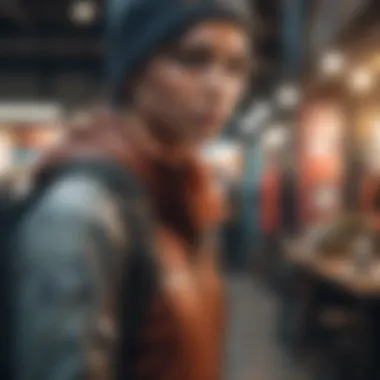The Rise of Indie Clothes Stores: A Marketplace Redefined


Intro
The landscape of fashion retail has transformed considerably over the past decade. Among various shifts, indie clothes stores have emerged as significant players. These establishments embrace a distinct ethos that separates them from mainstream retailers. A growing demand for unique styles, ethical practices, and community-focused shopping experiences fuels this rise.
Today, consumers are increasingly prioritizing individuality and sustainability in their purchasing decisions. The indie fashion sector capitalizes on this trend by offering curated selections that reflect diverse cultural narratives and encourage creativity. This article aims to investigate key factors driving the popularity of indie clothes stores, their impact on consumer behavior, and the broader implications for the fashion industry.
Techniques and Tips
Skill Development
To successfully navigate the indie clothing market, both consumers and retailers can benefit from certain skills. Understanding fashion trends is crucial for retailers. They should stay informed about emerging styles, colors, and materials. Workshops and online courses can provide valuable insights. For consumers, adopting a keen eye for unique pieces can enrich their wardrobe. Learning to mix and match outfits contributes to showcasing individual style.
Practical Techniques
Indie clothes stores often use marketing techniques that emphasize storytelling and personal connections. Stores can engage customers through social media platforms like Instagram and Facebook, sharing the stories behind their brands and products. In turn, customers can support these shops by participating in community events and sharing their purchases online.
Common Mistakes to Avoid
Both retailers and consumers should be cautious of certain pitfalls. Retailers often overlook the importance of customer feedback, which can guide future stock decisions. Not properly researching the target audience can lead to misaligned inventory choices. For consumers, one common mistake is prioritizing trends over personal style. Buying just for the sake of following trends may result in a closet full of items that do not resonate personally.
The Role of Sustainability
Indie clothing stores typically adopt sustainable practices that focus on environmental impact. Many utilize ethical production methods and materials sourced responsibly. This contrasts sharply with fast fashion, which often exploits labor and contributes significantly to pollution. By supporting indie stores, consumers help promote a model that values quality over quantity.
Community Engagement
A strong sense of community is at the heart of many indie clothes stores. These shops often collaborate with local artists, designers, and artisans, showcasing the unique talents of their neighborhoods. In return, they create invitations for customers to become part of something larger. Engaging in local markets, hosting workshops, and participating in charity events strengthens these community ties.
"Supporting local indie clothing stores helps to nurture creativity and diversity in fashion. It fosters a sense of belonging in an often impersonal retail environment."
Indie clothes stores are reshaping consumer habits by encouraging personalized shopping experiences. They offer a radical alternative to conventional retail methods that often prioritize profit over ethical considerations. This shift is essential for a more sustainable and inclusive fashion future.
Preface to Indie Clothes Stores
The rise of indie clothes stores signifies a notable shift in consumer behavior, where individuality and ethical considerations increasingly influence purchasing decisions. Unlike traditional retail outlets, these indie stores offer more than just clothing. They provide a sense of community, artistic expression, and a profound connection to their local environments. This intersection of fashion and culture makes the exploration of indie clothing particularly relevant today.
Indie clothes stores arise from a need for alternatives to mainstream fashion, which often lacks authenticity and engagement with consumer values. By focusing on unique, handcrafted designs, they cater to a customer base that seeks personalized experiences over mass-produced items. The significance of this topic lies in understanding how these stores respond to and shape the current landscape of fashion.
Elements of Indie Clothing Stores
- Authenticity: Indie stores promote original designs that may not conform to current trends. Each piece often tells a story, creating a rich tapestry of cultural narratives.
- Community Engagement: Many indie stores serve as hubs for local artists and designers, fostering connections within the community. This collaboration enriches the local culture and economy.
- Sustainability Focus: There is an increasing awareness among consumers about the environmental impact of fashion. Indie clothing retailers often prioritize sustainable practices, thus aligning with a growing consumer preference for ethical options.
Benefits of Indie Stores
The importance of these trends cannot be understated. By choosing indie, consumers not only support local businesses but also engage in a larger discourse around fashion ethics and identity. They contribute to a marketplace redefined, where labels and trends give way to more meaningful connections with clothing and the people behind it.
Considerations in the Indie Landscape
As the market becomes saturated with various indie clothing options, it is crucial to assess what defines success within this space. Factors such as brand story, customer engagement, and ethical production practices play a pivotal role in the sustainability and recognition of these businesses. This article will dive deeper into these elements, providing insights into the rise of indie clothes stores in detail.
"Indie clothing stores are not just businesses; they are ecosystems of culture and creativity, where every piece of clothing can create a narrative."
Defining Indie Clothing
Defining indie clothing is critical in understanding the place of indie shops in today’s market. These items often represent individuality, creativity, and a departure from mass-produced fashion. This section will clarify what indie clothing means and explore its core values which distinguish it from conventional apparel.
Indie clothing is characterized by its unique designs and smaller production runs. It typically embraces artistic expression, making it appealing for those who desire something outside standard trends. Moreover, it reflects a narrative of identity and personal storytelling. Each piece of clothing often tells a story. This aspect resonates with buyers who seek authenticity in their fashion choices.
Characteristics of Indie Clothing
Indie clothing possesses various distinct features:
- Unique Designs: Indie pieces often showcase original artistry, differing from the mass-produced variations in big retail chains.
- Limited Availability: Many indie brands create limited runs, ensuring exclusivity. This factor makes each item feel special.
- Quality Materials: Due to a focus on craftsmanship, indie brands pay more attention to the quality of fabrics and construction.
- Cultural Influences: Many indie labels draw inspiration from local cultures, subcultures, and emerging trends.
- Personalized Shopping Experience: Shopping in indie stores usually includes a more curated and personal experience.
- Sustainability Options: Increasingly, indie brands implement environmentally friendly practices.
These traits formulate a robust identity for indie clothing, setting it apart in the bustling fashion industry.


Comparison with Mainstream Fashion
When comparing indie clothing with mainstream fashion, several stark differences emerge. Mainstream fashion often prioritizes mass appeal and quick production cycles. Brands like Zara and H&M exemplify this approach, focusing on rapid turnover at the expense of unique identity. This model often leads to blandness in choices.
In contrast, indie clothing encourages individuality and craftsmanship. While mainstream fashion often follows seasonal trends, indie brands may not adhere to the typical seasonal calendar. This flexibility allows for creativity and unique interpretations of style. Additionally, indie labels usually respond more quickly to niche markets and consumer feedback.
An important aspect to note is the pricing. Mainstream fashion can often provide lower prices due to economies of scale. Indie clothing may carry a higher price point. However, that is often justified by superior quality and sustainability practices.
The distinction between these two realms highlights the importance of choice for consumers today.
Indie clothing offers a reflective approach to fashion, contrasting sharply with the fast-paced nature of mainstream brands. Its influence continues to shape consumer habits, encouraging a more thoughtful approach to shopping.
The Evolution of Indie Clothes Stores
The evolution of indie clothes stores is critical to understanding their current influence in the fashion industry. This section decodes the trajectory these stores have taken, emphasizing the foundations that have shaped them. The emphasis on individuality, sustainability, and the unique approach to community engagement makes this evolution particularly notable.
By observing how indie shops have transformed over the years, we can appreciate their role in diversifying consumer choices and challenging traditional retail norms. This matter resonates with consumers seeking authenticity and connection in their shopping experiences. Recognizing the significance of the evolution of indie stores reveals how they continuously adapt to the changing landscape of fashion.
Historical Context
In the late 20th century, indie clothes stores began emerging in response to the overwhelming dominance of fast fashion brands. Initially focusing on niche markets, these stores aimed to cater to specific subcultures and communities. The rise of the internet in the late 1990s played a pivotal role. Online platforms allowed small retailers to reach wider audiences without the need for large physical stores.
During this period, indie labels like Rag & Bone and A.P.C. began to gain recognition. Their offerings strayed from conventional trends, setting a precedent for what indie fashion could represent. Collectively, they championed authenticity through design and production processes. This era laid the groundwork for a more extensive indie fashion movement, driven by values that mainstream fashion often overlooks.
Emergence and Growth
The emergence of indie clothes stores gained momentum in the 2000s. Shoppers increasingly sought alternatives to fast fashion. Their desire for sustainable and ethically produced clothing turned indie options attractive.
Today, the indie clothing scene has witnessed significant growth. According to recent reports, indie retail sales have surged as consumers prioritize small businesses over large corporations. This shift has allowed brands to thrive by utilizing collaborative initiatives, pop-up shops, and social media marketing. Such strategies have fostered a strong community around indie brands.
Actually, platforms like Etsy and Depop have further accelerated this growth. They not only provide opportunities for new designers but also allow customers to connect directly with creators. The sense of community built around these outlets strengthens customer loyalty and cultivates an emotionally driven shopping experience.
"Indie fashion is not just about the clothes; it’s about the stories and values behind them."
By analyzing these developments, we can understand how indie clothes stores have redefined their place within the fashion marketplace. Their evolution represents a shifting paradigm, spearheaded by a demand for unique, sustainable options that reflect individual identities and cultural narratives.
Through understanding this progression, one can appreciate how indie stores have carved a niche in a marketplace that increasingly values its customers’ voices and choices.
Consumer Preferences and Trends
Understanding consumer preferences and trends is crucial for grasping how indie clothes stores have carved out their niche in the modern fashion landscape. These preferences reflect deeper shifts in values, aspirations, and lifestyle choices that are shaping shopping behavior today.
Demographics of Indie Shoppers
The demographic landscape of indie shoppers is diverse. Typically, these consumers range from millennials to Gen Z who prioritize authenticity and individuality. Many of them are environmentally conscious and are looking for apparel that aligns with their values. They appreciate the stories behind brands and are often willing to pay a premium for items that are produced ethically.
Some key demographics include:
- Younger Consumers: Often aged between 18 and 35, these individuals are driving trends within the indie market.
- Urban Dwellers: Many indie shoppers reside in urban areas where creativity and artistic expression are celebrated. They are frequently exposed to various cultures, influencing their fashion choices.
- Socially Conscious Individuals: A significant part of this demographic actively seeks brands that promote sustainability and community engagement.
These characteristics indicate a shift in focus from mass-produced goods towards unique, meaningful pieces that resonate with personal identity.
Shifts in Fashion Consumption
Changes in consumer habits are shaping how indie clothing stores operate. More shoppers are moving away from traditional retail experiences in favor of online platforms. E-commerce has expanded access to indie brands worldwide, allowing consumers to discover unique styles that go beyond local offerings.
Several notable shifts include:
- Personalization: Shoppers increasingly seek personalized experiences. They want to feel a connection with the products they purchase. Indie brands have capitalized on this trend by offering customization options.
- Value of Sustainability: Modern consumers are more informed about environmental issues than ever before. They often prefer brands that demonstrate environmental stewardship, including the use of sustainable materials and processes.
- Community-Focused Initiatives: Many indie stores engage actively with local communities, promoting local artists and hosting events. This approach not only strengthens local connections but also builds brand loyalty among consumers who support these initiatives.
"The rise of indie clothing stores signifies a fragmented but vibrant marketplace where individual expression is celebrated over mass conformity."
These shifts underscore a broader trend towards conscious consumption, where every purchase is a reflection of individual values and lifestyle choices. This evolution in consumer preferences not only impacts fashion retailers but also guides the future direction of the overall industry.
Sustainability in Indie Fashion


Sustainability has become a crucial topic in modern society, particularly in the context of fashion. The rise of indie clothes stores has brought this issue to the forefront. Indie stores are often founded on principles that prioritize ethical practices and environmental consciousness. This focus not only differentiates them from mainstream retailers but also resonates with consumers who value sustainable choices.
Indie fashion promotes sustainability through several avenues. Firstly, many indie brands adopt ethical production practices. This includes using fair labor and ensuring safe work conditions. When compared to large-scale fast fashion, which often exploits workers in developing countries, indie labels tend to place greater importance on the well-being of their employees. They often engage in small-batch production, which mitigates waste and promotes craftsmanship.
Here are some key elements when discussing ethical production:
- Transparency: Many indie brands openly share their supply chains and sourcing methods for fabrics.
- Fair Wages: They ensure that workers receive suitable wages for their work.
- Local Sourcing: Many indie stores source materials locally, which supports regional economies and reduces transportation emissions.
Additionally, environmental responsibility is a core aspect of the sustainability conversation within indie fashion. Many indie labels strive to minimize their ecological footprint. This can manifest in various ways. For instance, they may utilize organic materials or recycled fabrics in their designs. By avoiding harmful chemicals and processes often used in fast fashion, these brands contribute to a healthier planet.
Some strategies adopted by indie stores include:
- Waste Reduction: Brands often engage in practices that reduce fabric waste, such as using deadstock materials.
- Eco-friendly Packaging: Many indie companies prioritize biodegradable or minimal packaging to lessen environmental impact.
- Sustainable Transportation: They may opt for local delivery options or use carbon-neutral shipping methods.
The commitment to sustainability is not just a trend among indie clothes stores; it is a fundamental aspect of their identity and market appeal.
In summary, the importance of sustainability in indie fashion lies in its ability to address ethical, environmental, and social concerns. As consumers become more aware of the consequences of their purchases, indie stores position themselves as ideal choices for those who wish to align their values with their buying habits.
Community Engagement and Indie Stores
Community engagement is essential for the thriving ecosystem of indie clothes stores. These stores do more than sell items; they serve as hubs for creativity and connection. When local businesses engage with their communities, they foster a sense of belonging and pride. Customers are more likely to shop at stores they feel connected to. This connection is often cultivated through various initiatives that emphasize collaboration and support for local culture.
Local Collaborations
Local collaborations are a core strategy for indie stores to strengthen community ties. By partnering with local artists, musicians, or even cafes, they create unique experiences that go beyond traditional retail. These collaborations can take many forms, such as hosting pop-up shops, participating in local fairs, or showcasing local art in their shops.
Such partnerships not only enhance the shopping experience but also build networks within the community. For instance, when an indie store features a local artist’s work, it allows customers to discover new talent. This can increase foot traffic for both the store and the artist, driving mutual benefit.
Moreover, these collaborations often attract a diverse audience. People come together to support their local culture and, in turn, support the independent store. As a result, local collaborations promote a shared value of individuality and creativity that is at the heart of indie fashion.
Supporting Local Artists and Designers
Supporting local artists and designers is another important facet of community engagement for indie stores. These establishments tend to prioritize products made by local creators, which can range from clothing to accessories and artwork. This support provides artists and designers not only with a platform to showcase their work but also with necessary exposure in a highly competitive market.
Local artists benefit from sales opportunities, while indie stores enhance their offerings with unique and often one-of-a-kind items. Such products have stories behind them, which strengthens the emotional connection between the customer and the item.
"Community-focused initiatives create a rich tapestry of engagement that benefits both the store and its customers."
In summary, these efforts contribute significantly to the overall success of indie clothing retailers, turning them into cultural landmarks within their communities.
Challenges Facing Indie Clothes Stores
The indie clothes retail sector is marked by its innovation and unique offerings. However, behind the vibrant façade lies a multitude of challenges that these stores must navigate to thrive. Understanding these challenges is crucial as they directly impact not only the operation but also the future potential of indie retail businesses. The indie clothing marketplace is often overshadowed by larger, mainstream competitors, which sets the stage for various hurdles.
Market Competition
Indie clothes stores exist in a crowded marketplace where competition is fierce. Large retailers dominate consumer attention and often leverage vast resources to offer styles that, while not unique, are widely appealing. Many indie brands struggle to carve out space in this competitive environment. They compete against recognized names that benefit from established brand loyalty.
To effectively compete, indie clothing stores often emphasize their unique value propositions:
- Original Designs: Many indie brands focus on unique aesthetic that cannot be found in mass-market retailers.
- Quality Over Quantity: Indie retailers often prioritize craftsmanship and ethical materials, appealing to consumers interested in sustainability.
- Community Engagement: Many of these stores foster community relationships, enhancing customer loyalty through localized marketing efforts.
Despite these strengths, the competition can lead to detrimental effects such as price wars, which are tough for smaller brands. In addition, consumers might gravitate towards cheaper options available from mainstream retailers, creating an ongoing challenge for indie shops.
Financial Sustainability
Financial sustainability is another pressing issue for indie clothes stores. Unlike larger counterparts, these independent retailers often operate with tighter budgets and leaner profit margins. The initial costs of setting up and maintaining an indie clothing store can be substantial. Costs related to sourcing materials, labor, and marketing can quickly accumulate.
Indie retailers face distinct financial challenges:
- Cash Flow Management: Maintaining healthy cash flow can be tricky, especially for new businesses which may have fluctuating sales patterns.
- Investment in Marketing: To compete effectively, indie stores often need to invest significantly in marketing, especially digital strategies to reach potential consumers.
- Inventory Risk: Unsold inventory can plague indie shops, leading to losses. This risk is exacerbated by the need to offer diverse styles to attract a range of consumers.
The financial viability of these stores relies on a delicate balance between ceasing unnecessary expenditures and expanding their market reach. They must actively seek innovative approaches in financial planning to ensure survival in the competitive landscape.
"Every indie store must not only emphasize uniqueness in their products but also be financially astute to navigate the complexities of today's retail environment."


By tackling these challenges through strategic initiatives, indie clothing stores can not only survive but also thrive in an ever-evolving fashion landscape.
The Role of Technology in Indie Retail
The influence of technology on indie retail is profound and multifaceted. In today’s fast-paced world, indie clothes stores are compelled to adopt innovative technologies to stay competitive and relevant. This involvement not only enhances operational efficiency but also elevates customer engagement. The role of technology expands beyond mere sales; it facilitates a more personalized shopping experience and fosters community connections.
E-Commerce Influences
E-commerce has transformed the retail landscape. Indie clothes stores have embraced online platforms as essential tools for reaching a broader audience. They leverage websites and online marketplaces to showcase their unique products. This shift allows smaller brands to compete with larger retailers without the need for extensive physical infrastructure.
- Expanded Reach: By utilizing e-commerce, indie stores can target specific demographics across the globe, surpassing geographical limitations.
- Customer Insights: Advanced analytics tools enable indie retailers to gather data on customer preferences. Understanding buying behaviors fosters better inventory management.
- User-Friendly Experience: Streamlined websites that feature easy navigation, mobile responsiveness, and secure payment options contribute to a positive shopping experience.
This digital evolution equips indie stores to connect with their clientele more personally. Buyers can interact, share feedback, and even participate in community-driven initiatives.
Social Media Marketing Strategies
Social media platforms have emerged as powerful marketing tools for indie clothes stores. They offer a unique avenue for these retailers to build brand awareness and cultivate loyal communities.
- Brand Storytelling: By sharing the brand's narrative, values, and product details, indie stores create a more emotional connection with consumers. This storytelling resonates especially in niches that value individuality and sustainability.
- Visual Engagement: Platforms like Instagram and Pinterest excel at showcasing the aesthetic appeal of fashion. Engaging visuals of clothing items boost interest and encourage sharing, expanding organic reach.
- Targeted Campaigns: Paid advertising on social media allows indie retailers to target specific audience segments based on interests, behaviors, and demographics. This targeted approach increases the likelihood of conversions.
To sum up, technology is a critical aspect of the indie retail landscape. The integration of e-commerce and social media marketing strategies enables these stores not only to survive but thrive in a highly competitive environment. As they navigate challenges and opportunities, their adaptability may define future trends in fashion retail.
"Indie stores leverage technology to not just sell products but to connect with consumers on a deeper level, fostering community and loyalty."
The combination of these technological advances poses opportunities for indie retailers to redefine how they operate in the marketplace.
Cultural Significance of Indie Fashion
Indie fashion plays a crucial role in the contemporary fashion landscape, serving as a response to the highly commercialized nature of mainstream fashion. The cultural significance of indie clothing stores extends beyond mere aesthetics; they embody a philosophy that values individuality, diversity, and community. This section will delve into the specific elements that highlight the importance of indie fashion, highlighting its transformative impact on consumer behavior and the broader fabric of society.
Diversity in Fashion Narratives
Indie fashion embraces a myriad of styles, influences, and cultural narratives that often go unnoticed in mainstream retail. This diversity fosters a more inclusive approach to fashion, allowing underrepresented voices and perspectives to gain visibility. Indie clothing stores often showcase designs that reflect regional inspirations, cultural heritage, and personal stories. This variety not only enriches consumer choices but also encourages a sense of belonging among different social groups.
- Promoting Unique Aesthetics: Indie brands frequently prioritize artistry and originality. They often collaborate with local artists or utilize sustainable materials, creating unique pieces that stand apart in a saturated market.
- Representing Multiple Cultures: Many indie stores curate collections that resonate with specific cultural backgrounds. As shoppers explore these collections, they are exposed to new ideas and perspectives that challenge the conventional norms set by mainstream fashion.
By promoting diverse fashion narratives, indie clothing stores play a pivotal role in shaping a more inclusive fashion culture.
Identity and Self-Expression
Indie fashion allows individuals to express their identities freely. Unlike the uniformity often found in mainstream fashion, indie clothing provides an avenue for personal expression. Each purchase reflects a shopper's tastes, beliefs, and lifestyle choices.
- Empowerment Through Choice: Consumers are empowered to choose garments that resonate with their inner selves rather than conforming to mass-produced trends. This empowerment is crucial in a world where societal standards can dictate what is deemed 'normal' or 'acceptable.'
- Connection to the Community: Many indie shops foster community engagement through events and collaborations with local designers, artists, and musicians. This connection reinforces the idea that fashion is not just about clothing but about building relationships and supporting one's community.
"Indie clothing is more than just a purchase; it’s an investment in individuality and a connection to something greater."
Through the exploration of cultural narratives and self-expression, indie fashion emerges as a powerful force in reshaping consumer habits and societal norms.
Culmination: The Future of Indie Clothes Stores
The significance of this topic lies in understanding how indie clothes stores are not merely a trend but a pivotal force reshaping the fashion industry. The future of these stores addresses various essential elements, such as their role in promoting sustainability, showcasing unique identities, and nurturing community connections.
Impact on the Fashion Industry
Indie clothes stores are redefining the norms that mainstream fashion has traditionally followed. They challenge the one-size-fits-all approach often found in larger retailers. By emphasizing individual style and creativity, these stores encourage designers to explore unconventional ideas. This shift results in a richer tapestry of fashion where diversity is celebrated.
In addition, indie brands often prioritize ethical practices in their production. This includes everything from responsible sourcing of materials to fair labor practices. The competition from indie stores pushes mainstream brands to rethink their strategies. Brands are under growing pressure to adopt more ethical and sustainable practices, a change motivated by conscious consumer choices.
Moreover, indie stores have cultivated a unique space for marketing initiatives. The use of platforms like Instagram or TikTok enables these retailers to engage directly with their customers. They create strong narratives around their products and brands, successfully harnessing the power of storytelling in fashion.
Sustaining the Indie Movement
As indie clothes stores continue to grow, the need for sustainability in this movement becomes increasingly vital. Financial viability poses challenges, but there are ways to strengthen this niche. Collaborative projects that involve local artists provide both exposure and selling opportunities. By forming partnerships, indie stores can amplify their presence while contributing to the community.
Regular workshops, pop-up events, and community gatherings foster connections between consumers and brands, creating a loyal customer base. Engaging storytelling about the brand's origins, the designers' journeys, and the community involvement helps build a brand narrative that resonates deeply with consumers.
Supporting grass-root artists not only enhances the fashion landscape but facilitates cultural dialogues. In this way, sustaining the indie movement involves a commitment to both the economic and cultural fabric of the community.
Ultimately, the future of indie clothes stores holds potential for profound impact on both the industry and the community. By promoting individual expression, ethical production, and deeper consumer engagement, indie brands pave the way for a new era in fashion, where sustainability and identity take center stage.
"Indie fashion is not just about clothes; it's about fostering a culture that values originality and community over mass consumption."
The transition towards a more inclusive and sustainable fashion marketplace is underway. The evolution of indie clothing will play a crucial role in how consumers now and in the future experience and engage with fashion.







